Mind the gap[s]... within your mind. Understanding the tricks that our minds play on us 🤯 - a physicist has gone rogue perspective. Mind, Part I
17 Aug 2021
Disclaimer: the mind is perhaps the most advanced tool we have aquired due to the course of evolution. Nourish and treat it well, because it can take you anywhere, even to a dead-end alley.
However, if you need to talk to someone, always remember that there are people who can listen, for example, Samaritans in the UK on 116 123. You are not alone.
Last updated: 09.10.2021
Introduction
As the Covid-19 pandemic began to ease, I took a train from London to the coast of the South of England. As soon as I settled in a welcoming B&B, incidentally, run by a lovely couple from London, I went out for a walk along the Dorset's gorgeous coast. As I strolled along the peaceful sea in the distance, I spotted a seagull. It was on the edge of the seashore, and it tentatively tossed around a disposable surgical face mask. Then, the bird began to veraciously poke it around, hoping perhaps that the synthetic prey would spill out some nutritious rewards. Regardless of the creature's relentless effort, the mask did not tear apart. Its remarkable persistence reminded me of Hitchcock's "The Birds" movie, so I looked around if no more birds were nearby. Eventually, the critter gave up, leaving the piece of garbage to be washed away by the sea.
I managed to capture that particular moment with help of digital drawing skills that I aquired over the pandemic:
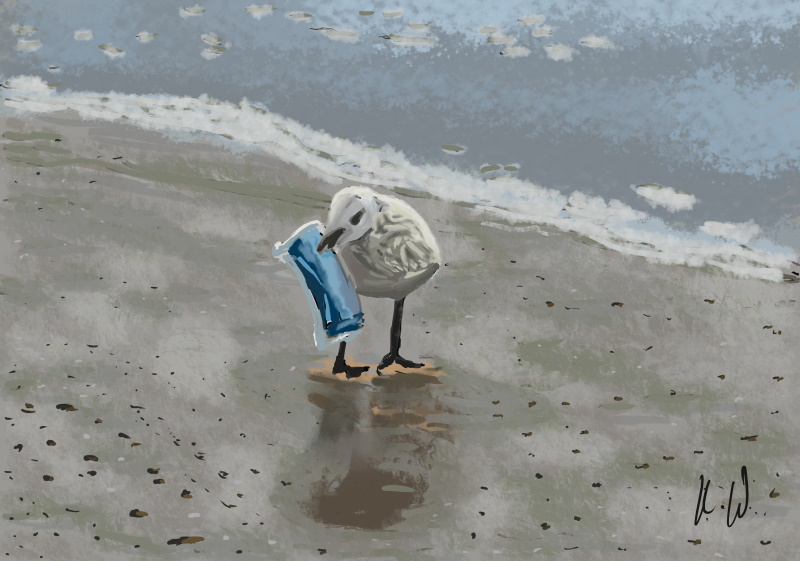
Buried deep in my thoughts, I continued walking along the sandy beach for some time until I faced rocks that told me without uttering a word: "there is no further way ahead." My mind was racing. I decided to dip my feet into the calm seawater to cool my body and distract my thoughts. During that moment, I managed to cast away all the world's affairs. The approaching evening allowed me to slip into a state of complete serenity, and the only thing I could focus on was icy but gentle licks of seawater. The cold waves carried away the straining heat and travel fatigue from my toes and feet. After some time, I felt rejuvenated, so I walked back to my accommodation. I completely forgot about the creature with the mask.
A few weeks later, I went for a walk around Barnes Common in London. I noticed several anti-vaccacine stickers stuck to roadside lantern posts:
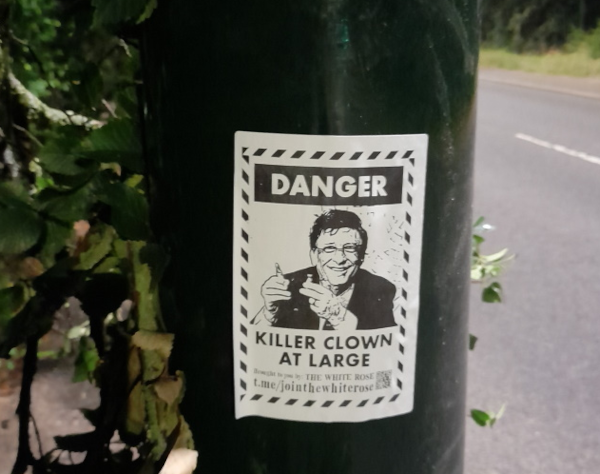
The image of 'pandemic seagull' flashed back in my mind. This prompted me to write this post.
I longed to refactor my essay on depression that I wrote some time ago; I removed it from the site because I believe it didn't encapsulate the message in the way I initially intended. Now I want to expand a little on the the subject of human cognitive biases and outline high level concepts on how mind works. Bear in mind that these are my notes either from 1) extensive rumination, 2) based on some academic courses or 3) spare time reading.
I view myself as a technical person who struggles to walk through the ether of daily chaos, which is why I am compiling this work to aid me with more clarity and share some reflections with the hope it might spark interest in someone fellow humans out there as well.
Furthermore, these subjects are important to me. Like many of you, I went through a volley of depressive episodes. Some stressful and upsetting life events in my past also shaped the way I think today. To protect me from future relapses, I need a set of reference points that I can use to remind myself of my past choices under these constraints. Lastly, I work with technology and understanding the shortcomings of my mind and the minds of others help me to make more informed decisions. Although, knowing more is not a fully prophylactic strategy, as I will explain in another part of these posts.
In this blog post I would like to:
- highlight some the key concepts that are behind our working minds and the way we process information. I will use these concepts to build framework for further discussion in part 2 and 3.
In part 2 of the series I would like to:
- touch and talk about the subject of depression & anxiety as I understand them from personal experience.
In part 3 I will:
- list some common mental and behavioural strategies that I find useful in my life to keep myself in a sustainable mental state to tackle daily challenges.
Cogs ⚙️ and bolts 🔩 of the mind - high level concepts
Feedback loops I made a simple diagram that represents a high level representation of two types of feedback mechanisms: negative feedback loop and positive feedback loop. I will use these simple representations in the discussion in this post:
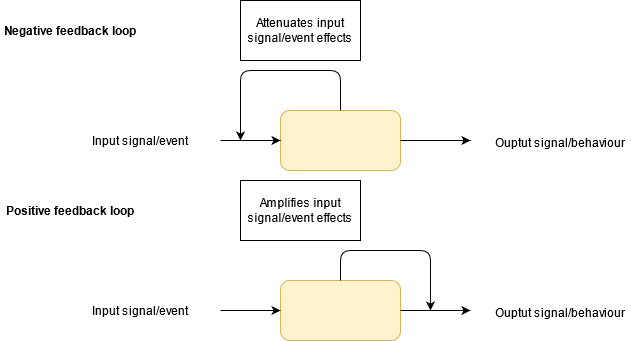
As a naive ex-physicist, I still think about everyday occurrences in incredibly abstract ways. I treat our minds as black boxes (or 'pale orange' boxes as in the image above). For example, the mind always receives some kind of input stimulus and then does some processing. Whether the signal comes from outside or inside, the box churns a response. The resulting action, internal body changes, motor responses (muscles moving in a certain way), verbal output, and overall behaviour, is the outcome we experience or people who interact with us receive. Sometimes we are not fully aware of why we came up with a specific set of actions because some were calculated without our awareness. Anyway, what happens inside can be complex, so let's ignore the complexity and focus on inputs and outputs first.
Let's consider negative feedback. In this case, the input signal that makes it into the box, for example, can be subject to a filter or attenuation. The output signal becomes less important in some downstream processes.
Let's take an elementary example. We are walking along the coast. The constant cold breeze makes us cold. Our brain calculates the rate of loss of heat. It figures out that it is higher than it can keep regenerating. Meanwhile, our body temperature is already decreasing. Our brain spits out a decision. In the first instance, it signals the muscles to start shivering to generate heat (our muscles are inefficient and produce a lot of heat when they twitch). At the same time, something activates a process in our higher cognitive layers. Suddenly, something reads a segment in our memory, and 'zap!' we remember putting some clothes in our rucksack. We reach for them, and we put them on. As a result, we reduce the heat loss rate on that slightly windy evening and our body temperature increases.
Negative feedback loop => counters some changeAs positive feedback loop, let's take up the most magnificent, yet incredibly tasking process that evolution selected for females: the birth of a new organism. A female mammal's uterus walls cause contractions as they give birth. The walls stretch further and further until childbirth occurs.
Positive feedback loop => amplify some changeNervous system Next to consider is a high level architecture of our nervous system. I made the following diagram outlining key elements of human nervous system (or any other vertebrates).
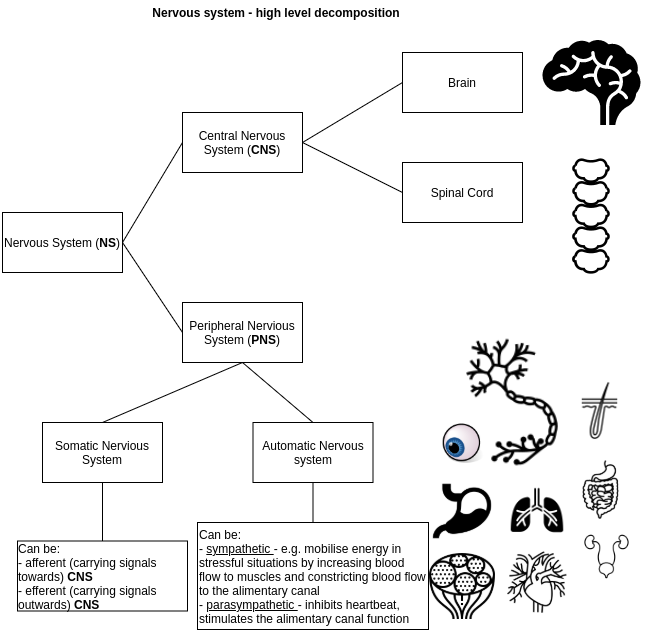
A Vertebrae nervous system, including humans, can be decomposed into two abstract layers: central nervous system (CNS) and peripheral nervous system (PNS). A central control system that is the brain and the vertebral cord continuously orchestrates signals from and to PNS. It also monitors blood for various fluctuations in the body's chemistry.
PNS, in turn, can be logically split into
somaticpart andautomaticpart. The somatic part can detect changes in the environment, e.g. visual or olfactory systems (olfactory = smell) and body ("shear and tear" receptors) and relays them to CNS. The somatic part of PNS can invoke various reflexes that allow us to make quick reactions.The
automaticpart of PNS, as the name suggests, is outside of voluntary control, e.g. our pupils either dilate or widen as brightness levels change, or our blood vessels constrict or dilate during the automatic temperature regulation.The automatic nervous system is divided into subcategories: the sympathetic and parasympathetic nervous systems. Both systems have complementary functions, and they operate in a perpetual tug of war game that aims to maintain the body's homeostasis. Homeostasis is the body's yin and yang ☯️, a state of equilibrium where biological conditions, say temperature, are kept at optimal levels for our biological cells to function. Thus different sorts of processes can continue to operate.
The important take from this section is that the nervous system is an information processing centre and learning system, wired to the internals of our body and external world through message carrying nerves. Its role is to be environmentally aware and track internal fluctuations within an organism.
Nervous and endocrine (hormonal) systems interaction While nerves carry messages that allow our brains to conduct fast decision making, another part of the feedback loop that our minds can execute control over our bodies includes the involvement of the endocrine system. The following diagram depicts a high-level view of the coupling between our nervous system and endocrine system:
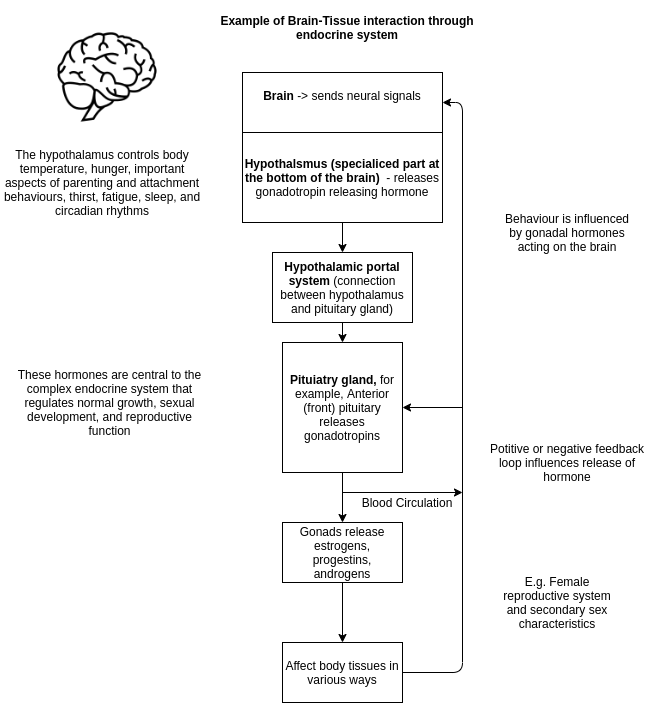
Without deep-diving into the nitty-gritty details of the interaction mechanisms, the major role of this relationship is to promote the secretion of hormones in various tissue parts across an organism.
Generally and loosely speaking, the onset of hormonal change can start in our brain, where the hypothalamus detects changes from the bloodstream or receives signals from the cerebrum. The pituitary, in turn, receives hormones or neuronal signals from the hypothalamus to release various hormones directly into the bloodstream. These travel in the blood to various parts of the body and either release certain processes within tissues or interact with tissues in some way to bring about a cascade of physiological changes. These system interactions can either exhibit negative or positive feedback mechanisms that spam long timescales, e.g., hours, days or more. In contrast, CNS and tissue interaction is almost instantaneous.
One example that I think would be relevant to this post should include Corticotrophin-releasing hormone (CRH) release from the hypothalamus. Technically, the part of the hypothalamus that does that is called the hypothalamic-pituitary-adrenal axis. CRH has a few crucial functions, but its primary role is to drive the stress hormone system.
CRH causes the release of adrenocorticotropic hormone (AH) in the pituitary gland. As AH travels through the bloodstream, it binds in adrenal glands (just layered above our kidneys), which stimulates the release of cortisol - the stress hormone. As cortisol levels increase in the bloodstream, body tissues prepare to release energy to deal with a stressful situation. Prolonged high cortisol levels can negatively affect the body, so its presence also causes suppression of CRH release; this is again an example of a negative feedback mechanism.
Other effects of CRH involve activation of other brain areas that suppress appetite, increases anxiety, improve memory and selective attention. Overall, these mechanisms impact behaviour and selection of response strategies in a stressful situation. Some scientists indicate that elevated levels of CRH in females contribute to labour induction.
Interestingly, leptin can suppress some effects of CRH on the brain; leptin is a hormone produced by adipose (fat) tissue. This interaction explains our apparent suppression of appetite during stressful situations.
It is worth mentioning that abnormalities in CRH levels can end up in various nervous problems such as clinical depression, sleep disorders, anorexia nervosa (eating disorders) or anxiety. Furthermore, CRH can induce and enhance some inflammatory issues like rheumatoid arthritis (joint inflammation), ulcerative colitis (inflammation and ulcers of the colon and rectum) or psoriasis (skin inflammation). The following picture shows my partner's skin changes after a traumatic episode in our lives:

After failing to a more diplomatic resolution, we decided to burn a few bridges with people that made our journey unnecessarily tasking, but I leave it at that.
To summarise this section, the points to take from here are following:
the CNS interacts with the endocrine systemthe endocrine system interacts with body tissues, through the blood circulatory system, to prepare us for various life events, usually through stimulating a secondary hormone releasethe secondary hormones can suppress the mechanisms that sparked primary hormone genesis to protect the body from harmful effects of prolonged hormonal shift
Event driven behaviour In this section, I will introduce a concept of interaction between the events that come from the environment and an organism's internal information encoding. I made a high-level workflow that tries to capture the flow of the interaction of events from its environment and influence, loosely speaking, the organism's resulting behaviours via genetic and epigenetic mechanisms
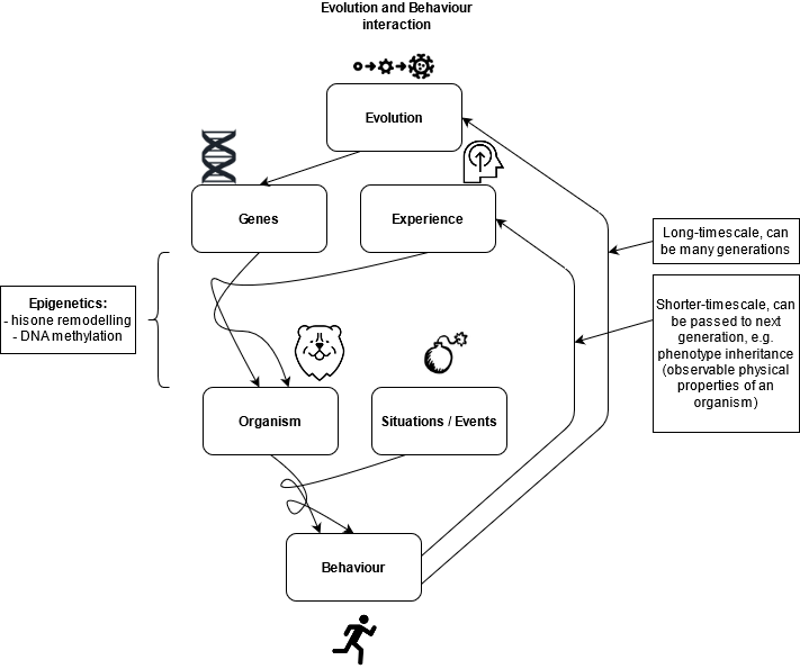
From sensory system to decision making I spent a substantial amount of time scratching my head about the processes that occur "under our skulls" when we interact with our surroundings. While it is difficult to reverse engineer the behavioural strategies that we undertake from just thinking about it or drawing it from individual experience. I made the following describing the interaction between our environment and the CNS churning out a response:
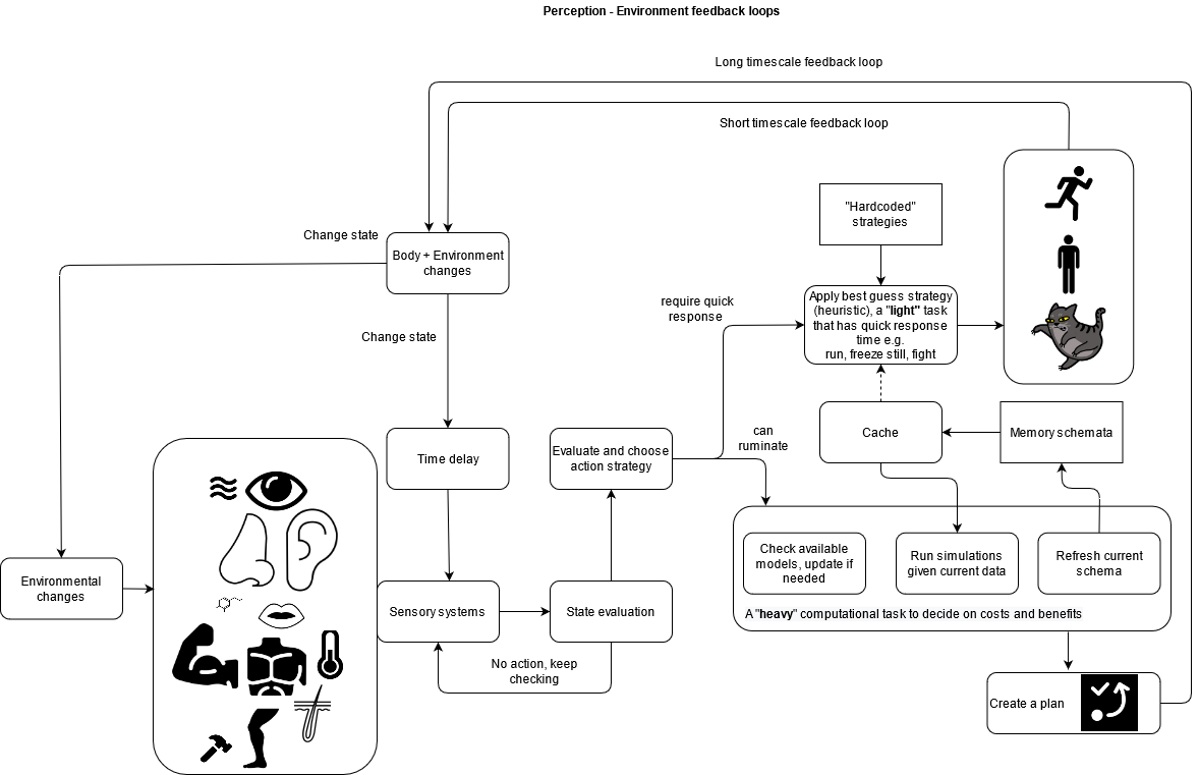
- Our sensory inputs come in many forms. Examples include a visual system, a smell detection system and a taste detection system. Mechanoreceptors, chemoreceptors and thermoreceptors in our skin can also detect harmful changes in the vicinity. I won't talk in much detail. If you want to zoom into the particulars, I added a list of textbooks at the end that you may find interesting. I want to make here that these somatic input channels filter and encapsulate information carried through nerves to specialised parts of our brain for processing. As a result of some internal calculation, a cascade of state changes initiate mechanisms for selecting a desired behavioural response.
- Somewhere between monitoring and responding, an agency triage and selects behavioural responses based on the urgency of the impending and evolving situation. If there is no time for deep thinking, for example, we see a bear in the distance, the brain tries to
guessa quick response. It might not be optimal, but it stops us from being stuck in a constant loop of calculating a decision. Swift action can increase our chance to escape the face of danger. For example, I am not waiting to find out if a bear walking in my direction is going to be friendly like in this one.However, in everyday decision-making, this adaptive feature in our brain can lead to what they call in psychology a cognitive bias. The cognitive biases are systematic errors in information processing that can be reinforced by repeating a less optimalguessrepeatedly until it becomes one of the default options in the case of a similar environmental trigger. -
On the other hand, if we are allowed to contemplate the next set of actions, the agent that activates the selection of future strategies has more freedom. Therefore, some can immediately go to the library of our memories and try to recall past experiences that match the current situation and pass them through mental blueprints shaped through experiences. Others can decide to take a nap to come up with a better solution calculated by offline processes. Another type of individual, perhaps, try research or join discussions with others to break down the problem. Sometimes, all these strategies can enrich schemata (mental plans) of different hypotheses in our minds. The future event can test their validity and help us re-evaluate and select hypotheses that withstand the trial of time; I will share the concept of machine learning in the next bullet. It is remarkably similar to a human and an animal learning process.
That's why we should try and aim to become omnivores of knowledge, attempt various things and see what nourishes and works for us. Nonetheless, I would caution anyone to give themselves time to try new things; they might not be as easy to digest as we had hoped in the first place.
-
I understand that the amount of stuff we have covered so far has been piling up, but bear (🐻) with me; we are making good progress.
Next, let us consider a workflow that data processing experts who use computers to build models for digital strategic decision-making 'agents.' A naive machine learning procedure can be described diagrammatically as follows:
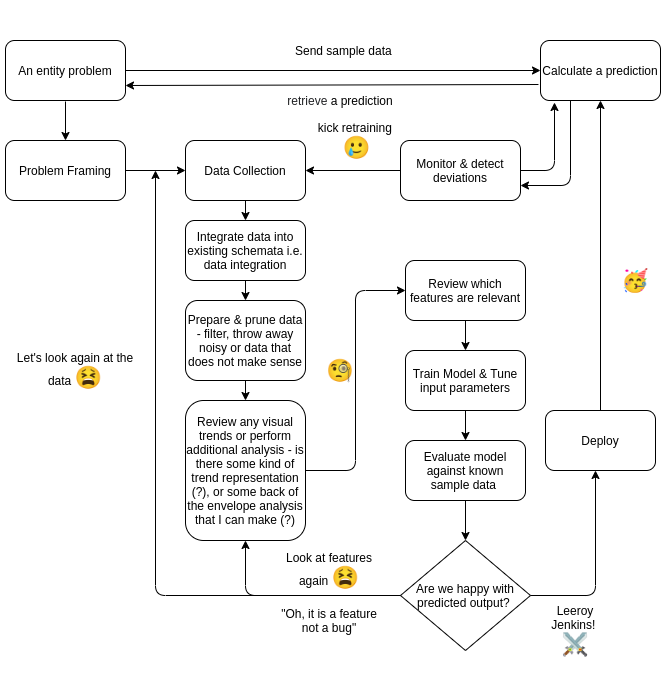
This field of study became so popular that it gained a fancy name: 'machine learning.' Machine learning models are utilities that data scientists build on specifically prepared datasets. At first, the data scientist asks a specific question about the domain they begin understanding. Then they seek to answer or find a way to disprove their initial assumption; they call it a hypothesis. The next phase is to interrogate the problem. They do it by gathering data, sifting through it, and then selecting the most critical features (e.g. individuals purchasing frequency, age, geographical location etc.), which they can think of to impact prediction making significantly.
Next, they spend some time tuning model parameters and build several versions of the model; this is similar to tuning guitar strings; we usually keep doing it until the strings make desirable sounds. Then they select a model that calculates probabilities with the highest accuracy of the outcome when they pass it some new event data containing specific problem features.
This might sounds too abstract, so let's try to imagine a specific example. Think of potential university students. We want to find out an answer to a question: "What is the probability that a student is going to drop out during their degree?" Having some kind of selection model could save us time processing student applications and allocating substitutes to enjoy the university experience.
Say we have a dataset of students' school records, including their attendance, net family income, ethnicity, set of extracurricular activities, subject of choice, academic family history, or whether the student had previously dropped out of their pursued set of studies.
We can create a table of records from our previous admissions. Now, we try to create a model that takes account of all these various features. Without making the process overly complicated, let's begin with collecting at dropout rates in previous years. We can prepare the data, choose a learning model, e.g. logistic regression, calculate probabilities, and even subtract a feature to determine the attribute's sensitivity to the prediction. We repeat it across all features, discarding attributes that have a small impact.
Now we have a benchmark model. We invite new candidates to the university that score well.
Suddenly, we have an ethical dilemma, are we making a difference? By removing potential candidates who are likely to be dropouts, aren't we cutting off candidates born unlucky but who have a real chance of making it to the end and inspiring others across the organisation and beyond? See discussion on survivorship bias in varying perspective and pattern matching section.
Mind's 'pendulum' I made a toy representation how I view the fluctuations of our states of mind as we get exposed to external or internal influences:
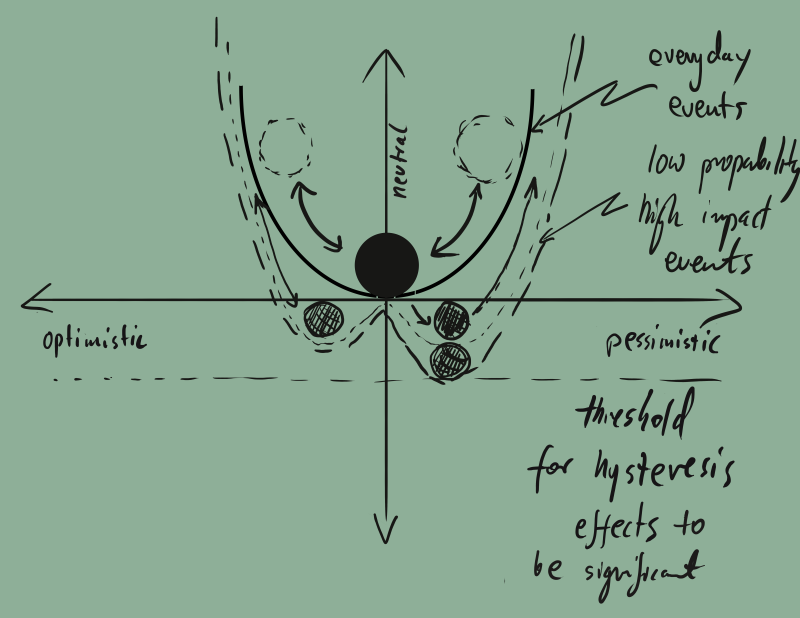
Learning capacity In this section, I would like to talk about the learning rate. The speed at which we pick up new tricks to overcome the challenges that life throws at us, or whether we experience rapid changes in our environment, can determine whether we survive or perish. I made a naive representation that shows our variability in speed and capacity to learn specific things in life against the passage of time:
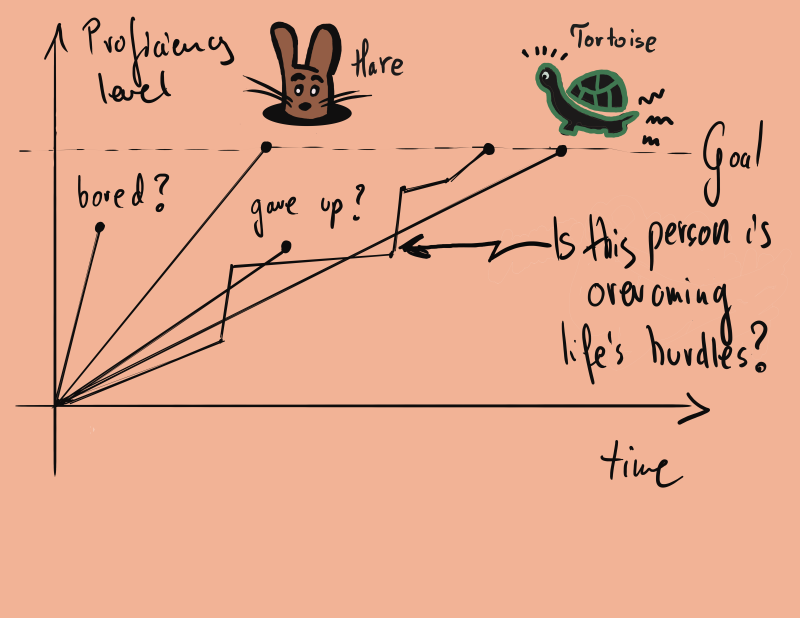
Regarding the above picture, let's assume that a group of people has similar learning goals. They all start at the same level of knowledge about a particular domain they are about to study. As time's arrow moves forward, they all make progress at different rates. The steeper the curve, the faster they are moving to their predefined aim. However, some swift learners might get bored at some point, so they stop and focus on something else. On the other end, we can find slower learners that give up as they don't believe they can finish the challenge. Then we have people in between.
In summary, we all learn at different rates. The rate we consume information, store it, process it, and use it to solve a spectrum of problems in life varies between individuals. For example, I am a slow learner, but at the same, I am very stubborn, so I try to reach the goals I set myself to achieve. In some situations, this can be advantageous; in others, it can be more of a behavioural nuisance. But more about that in the future.
Why is there such a stark difference between people? Well, the divergence arises from a variety of interactions between each individual and their environments. For example, parenting and events during our childhood development, the genetic & epigenetic differences we inherit and a bit of luck, e.g. avoiding brain-damaging accidents, all can contribute to this divergence.
Furthermore, these impacts in our behavioural strategies show the diversity and help our species survive.
Varying perspective and pattern matching As I mentioned in section "Mind's pendulum", we can fall on different sides of the perceived "pessimistic-optimistic" plain. I mentioned that the process could contribute to filtering the incoming stream of information that we process. In addition, we can also put different weights on the information bits that we recall from our memories. The filters that predefine our experiences can therefore be significantly different between individuals. The following simple drawing aims to capture the variation some of us possess between seeing the surrounding environment:
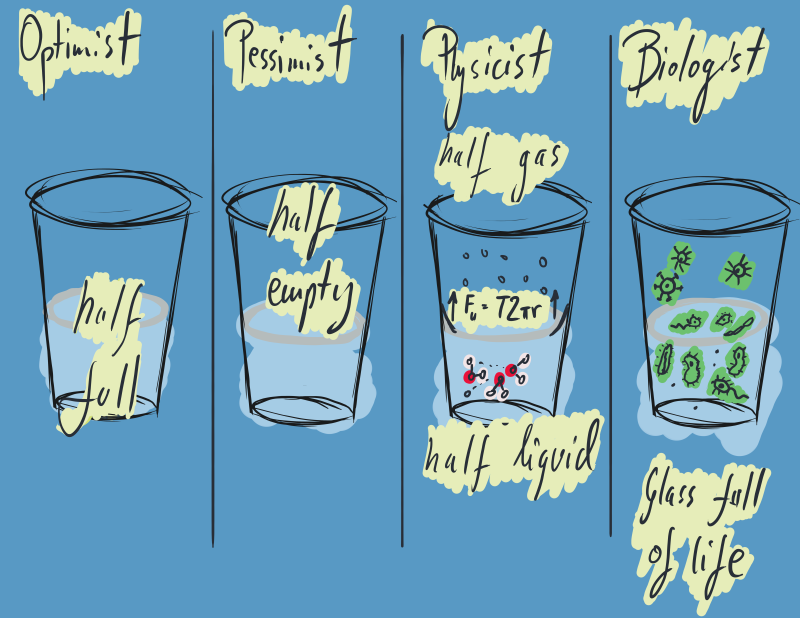
We take different sides when interpreting the reality that we experience, and the following set of pictures is another old concept example. When we hover on the right one, we notice that the red highlight could outline a young lady's face. On the other hand, when we hover over the right one, we can see an outline of an older lady; I hope you can agree on that. Both interpretations are equally valid; it is a tricky drawing that allows us to draw two different conclusions.
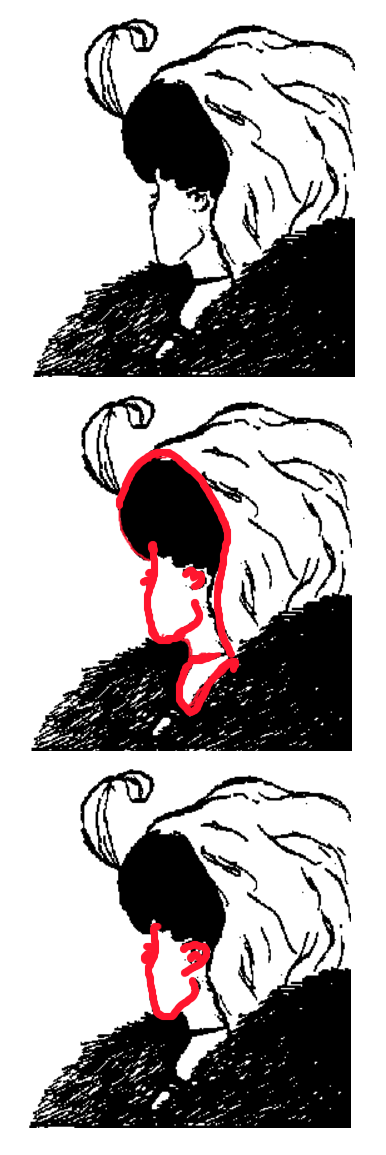

A brilliant example of paradigm shift had been used by Abraham Wald, who used
survivorship bias[1] in his statistical analysis to apply better shielding to military planes to minimise their losses to enemy fire. Wald recommended adding armour to the areas that showed the least damage because these represented the missing data of planes that never made it back to the base; this contradicted the US military's conclusion that the most-hit areas of the plane needed additional armour.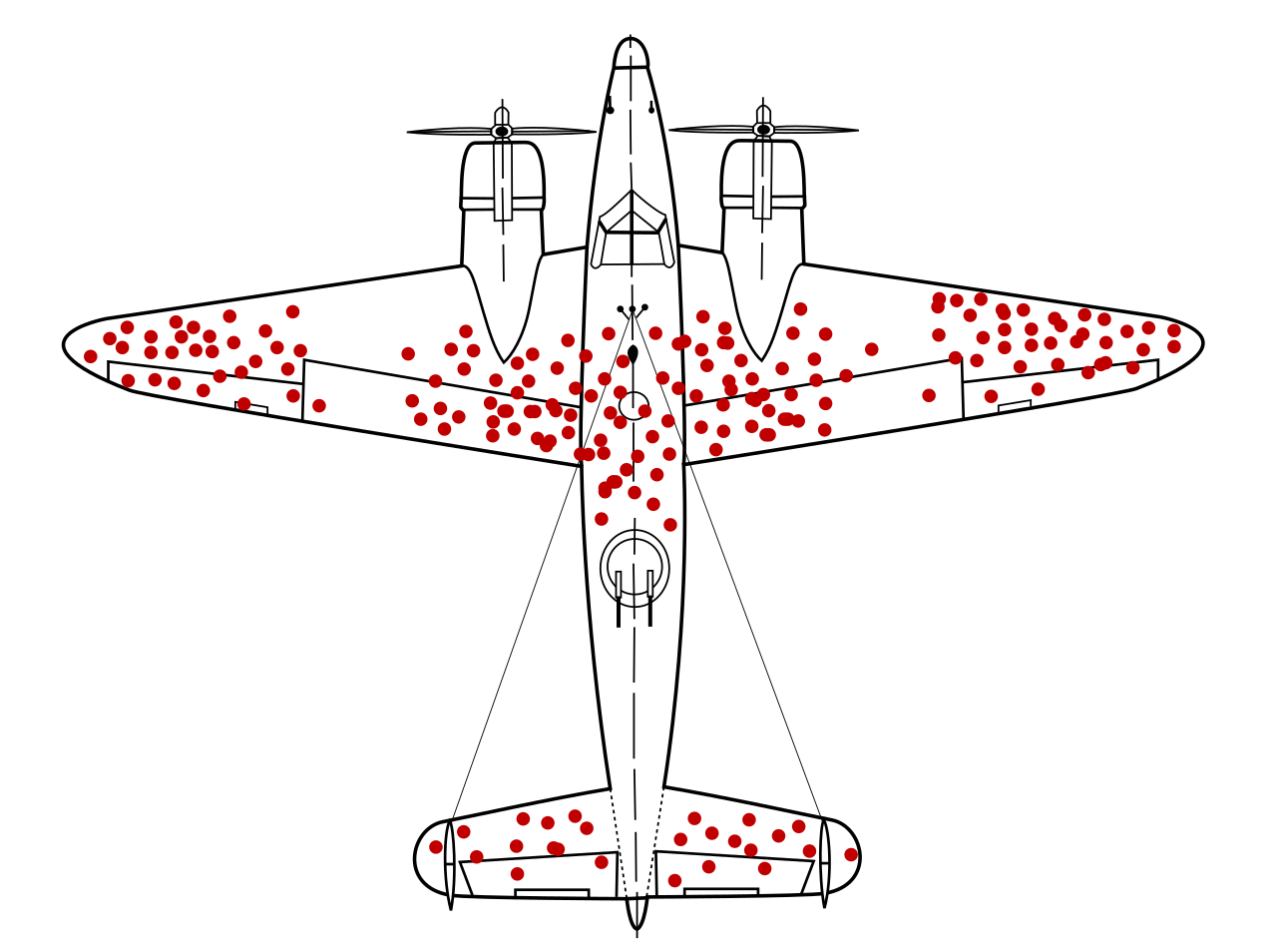
I made another diagram that encapsulated all different influences that affect our perspective. Each 'layer' of influence will vary between people and have a varying importance on our worldview. Note that I also assume that each layer is coupled to the other.
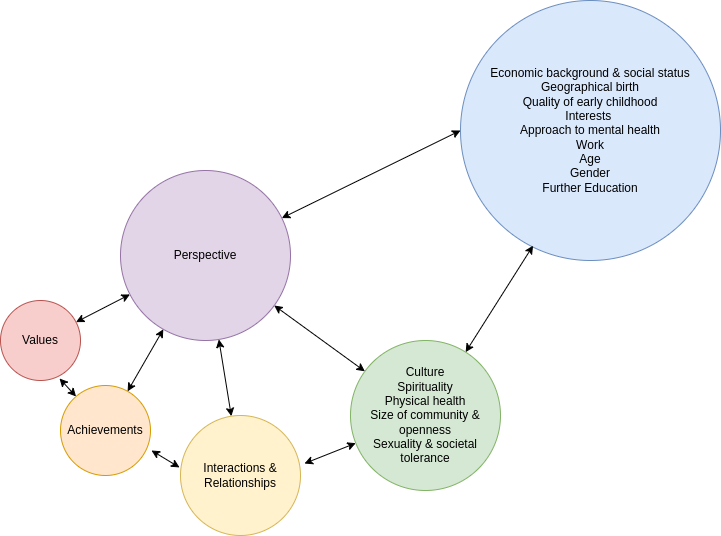
From the above examples, perhaps, we can agree that there are situations that we can interpret in different ways. However, they may not be equally valid in certain circumstances, which brings us to the last section.
Model equivalence I came across a simple yet powerful GIF image [2] that can aid us in understanding a concept called
model equivalence. When we view the picture below, we can see dots that are moving around. Our brains immediately try to fit some pattern to describe the motion. We can connect the dots in various ways. Each method aligns with the moving dots; thus, we can say that each model can be equivalent to describe the phenomenon. We make an enormous effort to develop the simplest model that describes a particular natural phenomenon in science. However, that is not easy, and we often require a lot of trial and error experimentation to weed out over-complicated hypotheses.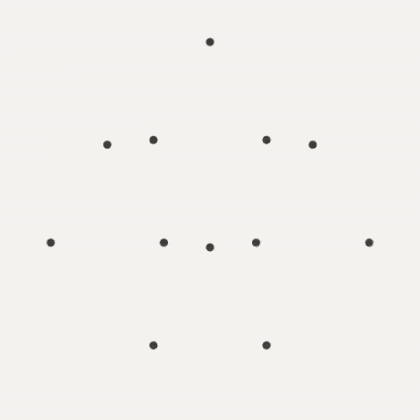
Sometimes I love the internet; more often, I despise it for being the biggest informational junkyard that is becoming awfully a challenging platform to filter through. Still, I found another picture on the internet that always makes me smile and will help me to explain another point in this section:
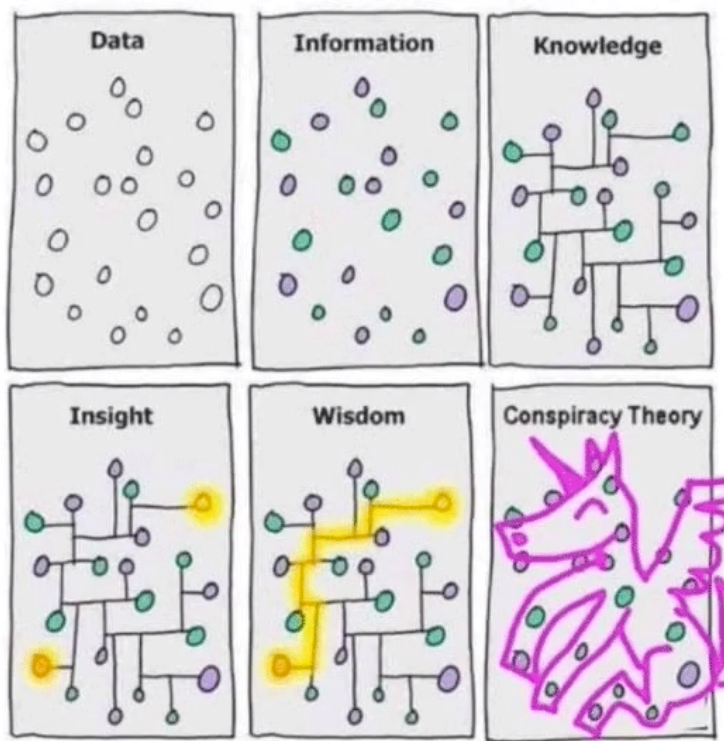
Our brains collect
dataabout our physical and virtual environments. Nowadays, the latter has a more significant role in shaping our worldview than in the past as we became interconnected on a global scale. Whether the news media article or some stranger's comment on what we posted on the internet, the events from across the globe carry an emotional impact. The data that we collect is filtered, transformed, amplified by our internal state of mind, for example, and then encoded and dumped into our memory storage that later serves as baseinformationthat we can refer to in the future.The amount of time the information persists in our mind depends on the weightings that our brain 'stamps on' when it moves into memory storage. Memories are not static and gradually decay over time. Perceived negative events can have higher weightings than positive ones, so when positive events decay away in our memories, the organ can create a pessimistic filter 😱. To counter that, we can develop thinking strategies to keeps us rebalancing on the pessimistic-optimistic scales; I will come back to this in parts 2 and 3.
Moving on, the internal processes can associate bits of information forming informational schemata, which becomes a fundamental framework for our
knowledge. The acquired knowledge can help us gain insights about our surrounding universe, i.e., form connections between causes and effects. On the other hand,wisdomgives us the ability to determine which causes and effects are real and which can be cognitive illusions. In contrast, conspiracy theorists lack this skill and might fit anything into the framework of their knowledge. However, it is not their fault. The way they process, information can serve them well to perform certain tasks that involve knowledge or even insight. In some circumstances, however, their way of thinking might not perform well in generalised tasks that involve higher levels of wisdom.
Let's summarise the above diagram. The organism's behaviour can influence genetic changes involving low-level information encapsulation within DNA encoding. This effect has a low probability of occurring within the lifespan of a single organism. Another way that information can pass to the offspring is through epigenetic changes.
The DNA chains are wrapped around certain proteins, and epigenetic changes can result in geometrical changes in the way DNA coils around these proteins. These changes can, in turn, impact transcription mechanisms that translate the DNA code into proteins used in our bodies. Loosely speaking, this is another way that environmental changes or events can influence the internal state of our bodies. This mechanism is probably more likely to occur within a single organism's life span and can be passed to its offspring, although it is still unclear how. Intellectual capacity is one of the features that offspring can inherit.
Either way, the interaction between the environment can impact internal mechanisms within our bodies that promote the encoding of information, such as a change within the framework of the DNA transcribing mechanism. For better or worse *, these data bits can be passed to the next generation of offspring and shape their direct behavioural strategies. *I will touch on that in part 2.
The diagram can be a bit overwhelming at first, so let's break down the discussion into steps following an event.
A lot is going on on this diagram, so let me explain. For simplicity of the discussion, Imagine that the black ball represents the state of mind in some kind of concave two-dimensional abstract structure. The ball 'likes' to sit at some centre that represents the mind's neutral state. As we experience day to day activities, the ball might wobble along the curvature. For this example, I labelled the horizontal axis to represent a magnitude of perceived 'pessimism' or 'optimism' with the change of its state.
The ball can persist in an elevated state for a short while on either side, but eventually, it drops off to the point of minimum, akin to a ball rolling back to the centre of a concave cavity due to gravity. However, we are dealing with an organic configuration that tries to return to its original state after recovering from an eventful perturbation, so perhaps a stretched rubber band returning to its exact length serves as a better analogy. Still, in both cases, the principle is the same. Therefore, you can imagine that our state of mind can rock back and forth in this two-dimensional representation daily.
I am sticking 'pessimism' and 'optimism' terms across the horizontal axis, which relates to how our brain emotionally 'labels' incoming information as events unfold. When we feel optimistic, our brain communicates that the risks or losses might not be that important. So it reinforces our actions. On the other hand, when we feel pessimistic, our brain calculates and tells us that the losses or risks might be significant. In this case, our brain discourages us from taking action.
One thing about the diagram is that the centre of the cavity can vary in a position slightly on the horizontal axis from person to person. Some people might be more optimistic, while others might be a little more inclined to be pessimistic. Further, the curve can shift one way or another throughout our lives.
The curve can also change shape due to traumatic events; broken curves below the horizontal axis indicate it. Such circumstances can either permanently or temporarily alter the initial concave curve, and it is akin to stretching a rubber band up to the point of permanent deformation. In an ideal world, the resulting minima could equally likely end up on either side of the vertical axis. However, evolutionarily the tendency to label negative events is more pronounced, resulting in a stronger bias to the pessimistic side. The mechanism serves to protect us from harm by limiting ourselves from making too many hasty decisions.
Okay, we covered now this 'pendulum' concept. Since it is fresh in our minds, let's make yet another toy drawing that shows some arbitrary operational metric that is a function representing a magnitude of some attribute that we perceive as being optimistic and pessimistic as its value change:

As you probably guessed, the path that the function is tracing is not constant in time. Furthermore, each individual coming across the same set of events will attach different weightings to them as they are recorded their memories for future reference. Therefore, the traces between individuals would not fully overlap if we could track the same metric between them. Still, they could be somewhat similar. Another common feature shared between people is that their traces can have moving average state values (broken horizontal line), moving up and down slowly.
The curious thing about the optimistic or pessimistic 'modes' is that they represent some cognitive filter. When we feel confident, we might sample information at a lower rate, so we will become more likely to underestimate the accuracy of future events. On the other hand, when we are pessimistic, we oversampling or overthinking incoming data and overestimate the probabilities of future events. That's why I indicated some imaginary boundaries where we either underestimate or overestimate errors in making predictions. An error in this context is the difference between the initial hypothesis and the value of an actual event.
Conclusion
There were several occasions in the past that I came across an interesting quote by Lao Tzu:
Watch your thoughts, they become your words;watch your words, they become your actions;watch your actions, they become your habits;watch your habits, they become your character;watch your character, it becomes your destiny.
In the context of what we covered so far, the quote by Lao partially makes sense - the way we perceive our surroundings and events that occur around us can create frameworks that shape the way we think and behave. However, I am not fully convinced we are in full control of the steering wheel of our minds; this is well captured by a quote by Menander:
So many cases I have knownOf men who, though not naturally rouges,Became so, through misfortune, by constraint.
The constraint may not necessarily be just the environment; it can be our learning capacity, as shaped by our inherited genetic configuration. We will come back to this point in the future.
Further Reading
Stephen Pinker. How The Mind Works. This book is very approachable. Perhaps one of my favourite popular science books implanted a seed in my mind to read more about the subject. It also inspired me to pick up writing this blog.
José Luis Bermúdez. Cognitive Science. An Introduction to the Science of the Mind. The book took me a while to through but made me engaged during the most challenging times of the pandemic journey. If you decide to find out more about the ways our mind works, go for this book.
Aubrey Manning & Marian Stamp Dawkins. An introduction to Animal Behviour. A very comprehensive introduction about animal behavioural patterns. Once you open it up, it will take to an incredible journey across the living beings and how their adaptive behaviours.
Eckert: Animal Physiology by David Randall. The book can be hard to dive into, but it is still a classic. The text illustrates the general principles of physiology at all levels of a living organism - from molecular mechanisms to regulated physiological systems to whole organisms in their environment.
Courses & Lectures
AP® Psychology - Course 2: How the Brain Works on Edx. An engaging introductory course by Steve J. Barnes, whose drawings make it fun to watch.
Robert Sapolsky Lectures on Youtube. Thanks to his lectures, I found joy in feeding the child-like curiosity that I lost for a brief period due to depression.
References
[1] https://en.wikipedia.org/wiki/Survivorship_bias
[2] https://psych-networks.com/meaning-model-equivalence-network-models-latent-variables-theoretical-space/